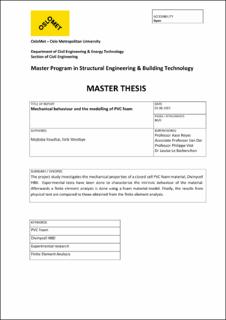| dc.description.abstract | Foam materials are widely applied in many industrial fields due to their superior characteristics regarding high strength to weight ratio. Additionally, they may offer high toleration to damage and exceptional energy absorption capacity. Therefore, a PVC foam of great mechanical performance, Divinycell H80, has been investigated in the current project report. First the mechanical properties of the foam are investigated by doing experiments, so that a good understandings of the behaviour of the material is established. Thereafter, a finite element analysis of the material was done to inspect the validity of the material model used.
In the project study the experiments done were compression tests and shear tests. The compression tests deemed viable results showcasing that Divinycell is an anisotropic foam. Additionally, it was confirmed that the mechanical strength of the material increases with increasing strain rate and foam density. Considering the shear tests, several shear tests were performed on the foam material, but the sample did not go through pure shear. This is investigated and analysed by using graphs, visual inspection and analysis software of the images taken during tests. After analysis of what happened during the tests, different modifications were made to both the sample and to the setup of the test. These modifications include reinforcing the sample with aluminium, making 3d-printed parts and CNC-manufactured parts for the test setup and investigation of the sample geometry and the effects of the changes. Lastly, an investigation is done of different articles that have found mechanical properties from shear tests with Divinycell or other materials in the past.
Finally, the compression results were modelled using the Deshpande-Fleck foam material model in LS-DYNA. This showed that the material model shows reasonable resemblance to physical compression tests performed, but densification occurs too early. However, the finite element model did not deform as wished, thus the results are looked at critically. | en_US |
